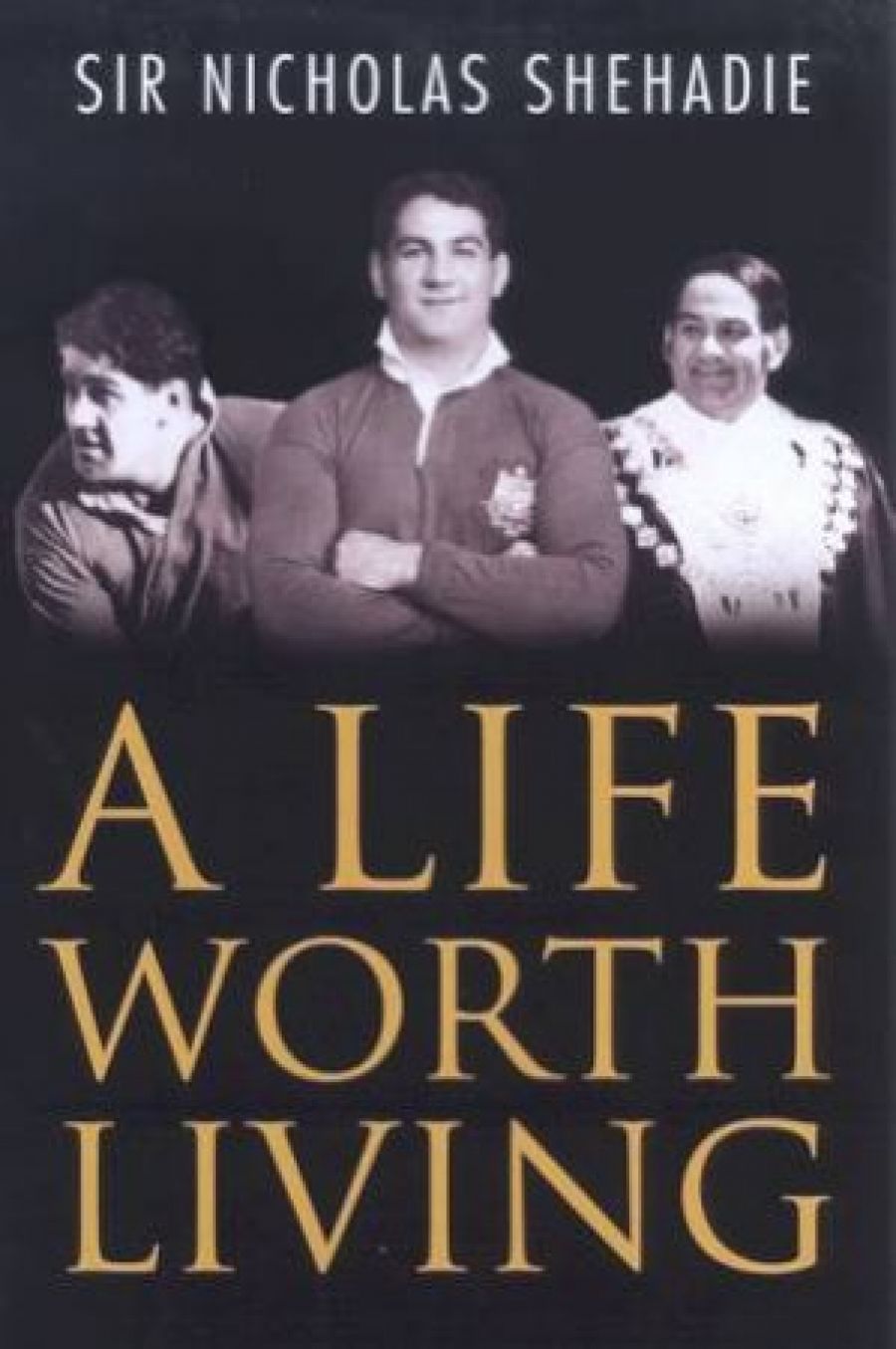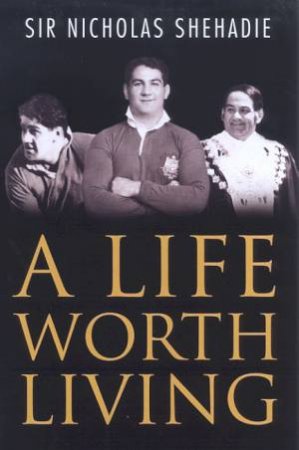
- Free Article: No
- Contents Category: Biography
- Review Article: Yes
- Article Title: A Scrummy Book
- Online Only: No
- Custom Highlight Text:
Not one word is wasted in Sir Nicholas Shehadie’s memoir, A Life Worth Living. Almost all the words are. This book is a triumph of lack of style over lack of substance. It’s a pity to attach such a proud word as ‘book’ to a publication like this, as it is to attach ‘music’ to two-fingered renditions of Chopsticks. Shehadie is no writer, nor does he pretend to be, which is a shame. A little pretence might have tricked up the work from being a tedious CV to a worthy member of Australia’s naïve school of sports memoirs, the current champion of which is Dawn Fraser’s energetic Dawn: One Hell of a Life (2001), with its patches of vivid, detailed recollection and clean, functional prose.
- Book 1 Title: ‘A Life Worth Living'
- Book 1 Biblio: Simon & Schuster, $29.95 pb, 255 pp
- Book 1 Cover Small (400 x 600):

- Book 1 Cover (800 x 1200):

Shehadie was one of Australia’s greatest rugby players. Rugby scribes recently voted him the forty-ninth best Wallaby of all time. That’s good, really – forty-nine’s excellent. Doubtless the publication of the memoir is timed for this month’s rugby World Cup, a four-yearly competition that Shehadie was instrumental in creating in the mid-1980s.
Shehadie, the son of impoverished Lebanese migrants, grew up in the Depression era slum of Redfern. He was a big, beefy kid, taunted as ‘Black Nick’ because of his dark skin. His prowess at rugby led to his being plucked out of the ghetto and into eastern suburbs’ social and professional circles. By middle age, he had achieved an almost aristocratic status. You would see him striding around the Members’ grandstands of Rosehill racecourse or the Sydney Cricket Ground, barrel-chested, straight-backed and expensively dressed, with social-climbers wanting to shake his hand as if he was of noble birth. He has been mayor of Sydney, chairman of SBS for nineteen years, a relatively successful businessman, a long-serving rugby and horseracing administrator, and a paragon of community service. His wife, Professor Marie Bashir, is the current governor of New South Wales. If there is such a thing as Sydney Establishment, he’s it.
Rugby boffins wanting to know Shehadie’s favourite coaches or his all-time dream team will find enough passages in A Life Worth Living to satisfy them. But a more demanding reader is advised to spend their $29.95 on something that demonstrates far more care for language and depth of, well, depth of pretty much anything. Self-analysis, gravity of feeling, social or political insightfulness, engaging revelation, are not to be found in these pages. There is little description to speak of, barely any detailed observation, and no images to please the mind. It’s as though Shehadie were only half interested in writing the damned thing at all. He conveys memories of his childhood and youth in a throwaway anti-language of clichés as if he can’t remember the period too well. Redfern was the ‘school of hard knocks’ where ‘you made your own fun’. Families were ‘close-knit’ and ‘exciting times lay ahead’.
Having led a charmed, middle-class life, I have no idea what the school of hard knocks is. I would have liked Shehadie to build it for me on the page. He could have cut all manner of clangers to accommodate it. There’s the one about Easter being ‘a religious occasion and a time to reflect’. And, ‘We were en route to the Iranian capital, Tehran, to meet with that city’s lord mayor, who was to make an official visit to Sydney as a guest of the Australian government. Sadly, he was executed in that country’s subsequent coup.’ ‘We were met on our arrival in Rome by the Australian ambassador.’ Or my personal favourite: ‘As chairman of the membership committee I had a lot to do with members and membership issues.’
I know little about this man after reading his memoir. His is a ‘did this, did that’ summary of the years. On at least three occasions, I felt angered by his avoidance of politics and his apparent disinclination to say anything that could be construed as controversial – this despite having spent much of his adult life as a politician.
Perhaps he felt he should be above politics now that he’s first man. Whatever the reason, it creates a weird effect: the author suffers bouts of politicus interruptus. He allows himself a couple of sentences to laud current immigration minister, Philip Ruddock, who defeated him in a 1973 Liberal Party preselection battle for the federal seat of Parramatta: ‘I lost to a very fine man. I got to know Philip Ruddock quite well after that encounter and hold him in high regard.’ And that’s it. He abandons the subject before the politics goes too far. He spends a few pages sharing his thoughts on multiculturalism. They read like a patronising Australia Day speech drafted by PR hacks: ‘Immigrants have made a tremendous contribution to the development of Australia in many fields.’ But one attack of interruptus has distasteful consequences.
Recounting his selection for the 1953 Wallaby tour of South Africa, at the height of apartheid, he says, ‘I felt some concern, though, because of my dark complexion and Lebanese background. Would I be admitted into the country or be embarrassed there by their apartheid system? I requested that the Australian Rugby Union check out this situation before leaving, and they assured me that everything would be okay.’ Embarrassed? Outraged, disgusted, contemptuous. But embarrassed? And what was meant by, ‘everything would be okay’?
We’ll never know. The matter gets no further mention. He recalls the jaunty old time he had in the republic: the dances, the wild animals, the Test matches, a visit to Rhodesia, the many servants. We learn that he formed opinions on South African culture and its apartheid laws, but we’re told this only in passing and in the context of Shehadie’s courting Bashir. When he invited her to a film night about the trip, ‘She seemed to indicate great interest in my views.’ What those views were we’re not privy to. He doesn’t take the reader into his confidence, which defeats the whole purpose of writing a memoir, and makes A Life Worth Living not worth reading.


Comments powered by CComment